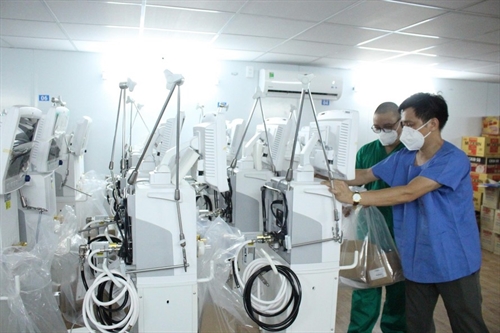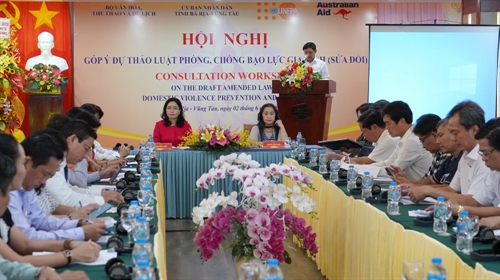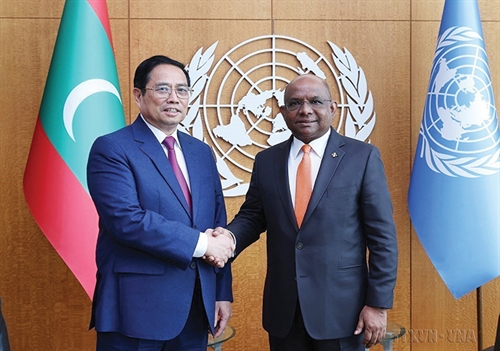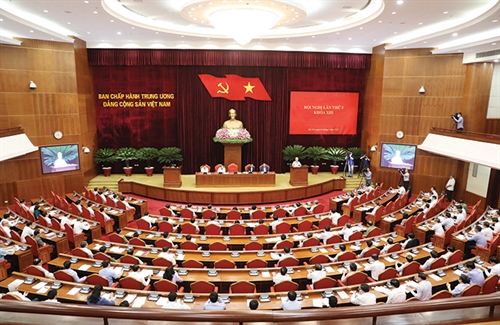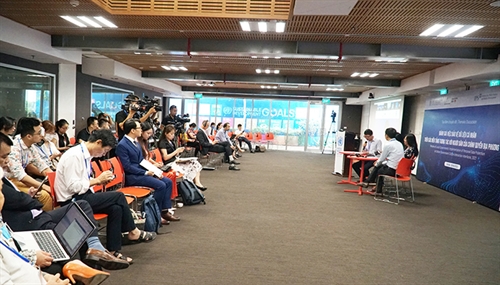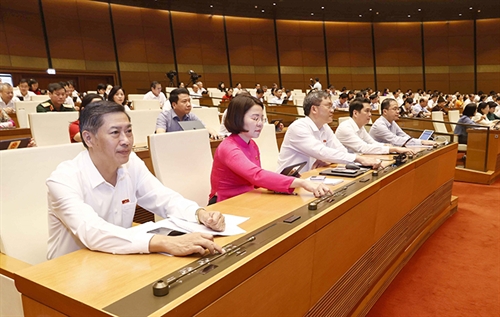Assoc. Prof. Dr. Nguyen Hong Son
Deputy Head
The CPV Central Committee’s Economic Commission
On June 16, 2022, the Communist Party of Vietnam (CPV) Central Committee adopted Resolution 18-NQ/TW on “continuing to renew and improve institutions and policies to raise the effectiveness and efficiency of land management and use, creating a momentum for Vietnam to become a high-income developed country” with many new breakthrough ideas. The Resolution put forth the orientations for substantive settlement of long-existing land-related hurdles and constraints (such as land originating from state farms or forestry camps, residential land, production land for ethnic minorities, religious land, land of production establishments or public non-business units already relocated from major urban centers, and post-equitization land) and newly emerging issues (defense and security land used for production and economic activities, multi-purpose land, sea-encroachment land, etc.) so as to accelerate the country’s fast and sustainable development according to new land use planning orientations; land allocation and lease; support, compensation, resettlement, land recovery; land prices; land finance; administrative reform in land management; raising the land management capability, etc.
These new breakthrough ideas have been demonstrated throughout the contents of the Resolution, from the viewpoints, objectives to tasks, solutions and implementation organization. They can be summarized into three major points: (i) raising the market’s role in land management and use; (ii) heightening the role of the owner’s representative and the State’s management over land; resolutely preventing and fighting corruptions and negative practices in the land domain; and (iii) ensuring the harmony of interests between the people, investors and the State, in which the people are placed at the center and nobody will be left behind. These also are the main requirements set for the strengthening of land-related institutions and policies.
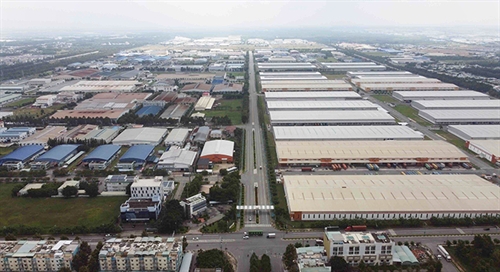 |
Vietnam-Singapore Industrial Park II in Thu Dau Mot city, Binh Duong province, which is home to 116 local and foreign-invested businesses__Photo: Vu Sinh/VNA |
| Vietnam-Singapore Industrial Park II in Thu Dau Mot city, Binh Duong province, which is home to 116 local and foreign-invested businesses__Photo: Vu Sinh/VNA |
Raising the market’s role in land management and use
Land is a limited resource which is extremely important for development. Therefore, in order to bring this resource into the fullest play, it should be allocated to sectors, industries and people that can use it most efficiently for socio-economic development. Both theory and practice show that the market is the most effective mechanism to achieve this. A higher role of the market in land management and use will help enhance publicity and transparency. As a result, the market will operate more efficiently and the State can acquire sufficient information to administer and regulate the market.
The orientations to heighten the market’s role in land management and use in Resolution 18-NQ/TW consist of the following basic points:
First, the Resolution puts forth the requirement to renew and improve the institutions and policies on land management and use in conformity with the institutions on development of the socialist-oriented market economy.
Second, it affirms “land belongs to the all-people ownership with the State acting as the owner’s representative and performing the unified management” and at the same time clearly points out the property characteristic of land use rights: “Land use rights constitute a special type of property and commodity but are not ownership rights”. This will help land use rights well operate in the socialist-oriented market economy.
Third, the Resolution directs the expansion of the access to land for people and enterprises. It goes on to point out concrete measures as raising agricultural land use right transfer quotas and broadening eligible subjects, land allocation and lease to be carried out mainly through the forms of land use right auction and land-using project bidding[1]; abolishing land price frames and applying mechanisms and methods of determining land prices under the market principle[2]; further applying the mechanism of mutual agreement between enterprises and people in land use right transfer and execution of projects on urban areas and commercial houses; early elaborating mechanisms and policies that enable individuals, organizations and households to participate in investment projects through land use right transfer, lease or capital contribution; establishing agricultural land-leasing banks; accelerating commercialization of land use rights, etc.
In Vietnam, the process of concentrating and accumulating agricultural land is taking place at a slow pace. Agricultural land is mainly of small sizes with around 78 million plots, big or small, averagely 2.5 plots of about 0.5 ha per household; the number of households using over five hectares of agricultural land represents just some 3 percent of the total 8.8 million farming households. The number of enterprises investing in agriculture accounts for about 1 percent of the total number of enterprises nationwide. One of the causes of land being left wasteful is the application of the policy on exemption of agricultural land use tax, which puts no pressure on farmers to return or exploit their land. Once the agricultural land-lease bank is set up, they will feel at ease to lease their land to it for sub-lease to enterprises.
Therefore, the orientation on elevating the role of the market in land management and use will help the land use rights market become more flexible, creating favorable conditions for land concentration and application of new and advanced technologies to agricultural production, thereby increasing the land use efficiency. This will also create conditions for enterprises to access land and be more active in production and business activities; increase the publicity and transparency, thus curbing acts of corruption and negative practices in land management and use.
Heightening the role of the owner’s representative and the State’s land management capability
Land is not only a limited resource and an important resource for national development but also the national territory and the space of the nation’s existence. Therefore, it should be not only efficiently managed and used but also protected, managed and used in a sustainable and thrifty manner and for correct purposes.
As clearly articulated in the Resolution that land belongs to the all-people ownership with the State acting as the owner’s representative and performing the united management, the heightening of the role of the owner’s representative and the State’s land management capability is of very important significance to ensure that land is managed and used for the common interests of the entire population and people can access and use it in a fair, public, efficient and sustainable manner. Once the role of the owner’s representative and the State’s land management capability are raised, land will be managed and used in a transparent and public manner; the real estate market will be regulated for healthier and more efficient development. At the same time, the discipline in land management and use will also be further enhanced, thus minimizing negative practices, waste and corruption in land management and use.
The orientations to raise the role of the owner’s representative and the State’s land management capability are manifest in the following basic points:
First, the Resolution stresses the significance of the all-people ownership of land with the State acting as the owner’s representative and performing the unified management and further specifies the State’s unified management of land. The all-people’s ownership of land is inseparable from the unified management by the State in its capacity as the owner’s representative. The all-people ownership aims to ensure that land is managed and used for the common interests of the entire population, and people are given conditions to access and use land in a fair, public, efficient and sustainable manner. The State’s unified management of land means management according to national territory, including the natural areas, quality, economic values, culture, society, defense, security and environment; with the rational assignment of responsibilities among state bodies at the central government and the appropriate and efficient decentralization to local administrations.
The second point is to renew and raise the quality of land-use master plans and plans. Land-use master plans need long-term visions, consistency and synchronism; combining land quotas in association with land use space, zoning and natural ecosystem. Especially, the Resolution clearly states: “The State will ensure adequate resources for the elaboration of land-use zoning and master plans on land-using sectors and domains”.
Recently, many localities have mobilized social resources, particularly from investors or enterprises, for the elaboration of master plans. This, on the one hand, helps the master plans close to reality but, on the other hand, harbors risks of abuse and negative practices, particularly when the investors or enterprises bend the master plans in their favor. The supply of adequate funding by the State for elaboration of master plans will minimize such risks, thereby raising the State’s effectiveness and efficiency in land management and use.
The third point is to apply synchronous and specific measures to cases in which the State has assigned or leased land but the recipients failed or are late to put the land to use[3]. The State will resolutely recover the land of organizations, state bodies or non-business units when the latter use it for wrong purposes, particularly land at advantaged positions, being able to yield high profits, in order to prevent the loss of state funds and property[4].
The fourth is to strengthen the organizational structure of state management of land in a streamlined, effective, efficient, synchronous and unified manner; improve the capabilities and qualifications of officials and civil servants in the land management sector; promote administrative reform; apply modern technology and digital transformation in the state management of land, focusing on building centralized, unified and modern databases on land.
These databases on land should be established synchronously and consistently to include not only quantity, quality and acreage but also value and transaction records. When databases on land are digitalized, all changes, including those in value and transfer of land, will be easily tracked. All land transactions will be transparent, specific and visualized. This will help the State better perform the function of representing the land owner through the provision of information and reports. At the same time, the management effectiveness and efficiency will be raised when the State obtains adequate information for the issuance of management decisions.
The fifth point is to step to the land management decentralization in close association with implementation conditions and control and oversight of the implementation process. The Resolution requires the enhancement of the Party’s leadership and the role of related parties in land management and use, especially the responsibility of leaders; renewal and intensification of the Party’s examination and supervision work and the State’s inspection, examination, oversight and control activities; the heightening of the role of judicial bodies in the settlement of land-related disputes, complaints and denunciations; and the raising of the supervisory role of the National Assembly, related parties and people. All these will help raise the flexibility, proactivity and creativity of local administrations as well as prevent corruption and negative practices.
The last point is to concentrate investment resources for land resource surveys and evaluation; land statistics and inventory; land use oversight; land protection, improvement and rehabilitation[5]. This will help manage and use land more thriftily and sustainably.
Ensuring harmony of interests between people, investors and the State
This orientation aims to reduce land-related complaints, lawsuits, disputes and denunciations[6] and tackle the problem of land waste or misuse.
The requirement to ensure harmony of interests between people, investors and the State, in which the people are placed at the center and nobody will be left behind, is manifest in the following basic points:
First, the Resolution prescribes more specifically the land recovery competence, purposes, scope, conditions and criteria of land recovery by the State for socio-economic development for national and public interests. If land recovery by the State requires resettlement, the resettlement should be carried out before the land recovery. At the same time, it requires to ensure the people’s livelihoods, concretely supporting them in vocational training, job creation and production restructuring.
Realities show that in the recent past, a number of localities have not strictly complied with the laws on compensation, support, resettlement upon land recovery by the State, such as failing to establish resettlement areas before issuing land recovery decisions or create jobs for people with land recovered.
Second, land-related financial policies must ensure the harmony of interests between the State, land users and investors.
The Resolution puts forth the orientation of imposing higher tax rates on persons using multiple land plots, homes or speculating land, belatedly using allocated land or leaving land unused. At the same time, it sets the requirement to apply preferential policies on tax, land use levy and land rent suitable to sectors and geographical areas eligible for investment priority; for poor households, ethnic minorities, families with meritorious services to the revolution; areas planned for production to ensure national food security, for protection of protection and special-use forests, etc.
The Resolution also requires a review of tax policies and laws on land use rights transfer, providing grounds for the formulation and improvement of land use right transfer tax policies in line with international practices as well as Vietnam’s conditions and circumstances and according to a proper roadmap.
Third, in addition to the orientation on early formulation and finalization of mechanisms and policies for individuals, organizations and households to be able to take part in investment projects through land-use right transfer, lease or capital contribution, the Resolution also requires the issuance of specific regulations on efficient use of land areas adjacent to infrastructure works and introduction of preferential policies for people having land recovered.
So, the above-mentioned new breakthrough ideas area also the Party’s important requirements on the improvement of land institutions and policies, with a focus on the revision of the 2013 Land Law and other relevant laws. This is basically the requirement to properly handle the relationship between the State, the market and society in land management and use.
The institutionalization of the Party’s policies on land management and use will create a synchronous, strict and unified legal corridor, ensuring that the State will have adequate legal tools for the exercise of the rights and obligations as the representative of land owner and land users. The market’s higher role in land management and use will result in a more rational and efficient distribution of land. All these together with the assurance of the harmony of interests between the people, investors and the State in land management and use will help minimize waste and negative practices; reduce land-related disputes, complaints and lawsuits, and promote the thrifty, efficient and sustainable use of land, thereby contributing to boosting the socio-economic development, defense and security maintenance, environmental protection and climate change response.-
